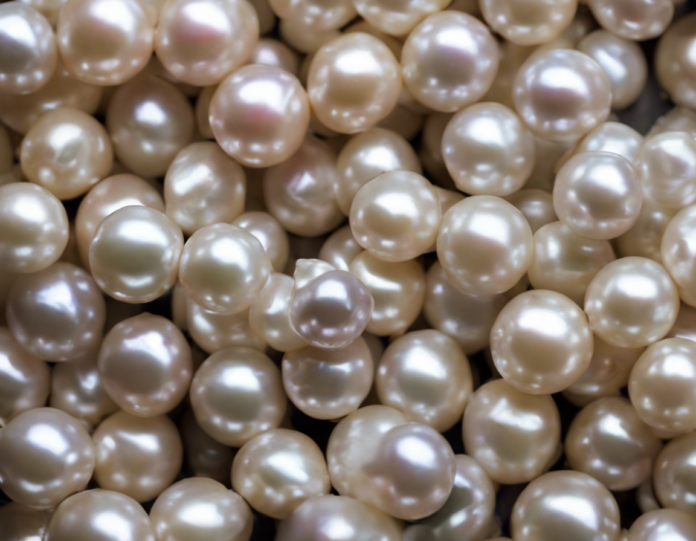Gron pearls are a fascinating and unique type of gem that has been gaining popularity in recent years. These pearls are not like the traditional pearls that come from oysters or mussels; instead, gron pearls are formed inside the bodies of a type of giant clam known as the Tridacna gigas. This process results in pearls that have a distinctive iridescent sheen and a range of vibrant colors that set them apart from other gemstones. In this comprehensive guide, we will explore the beauty of gron pearls, their characteristics, how they are formed, and how to care for them properly.
What are Gron Pearls?
Gron pearls, also known as queen pearls, are unique gemstones that are formed inside the shells of giant clams. These clams, which are found in the waters of the South Pacific, produce pearls with a stunning array of colors, including blues, purples, pinks, and greens. Gron pearls are highly sought after for their vibrant hues and iridescent sheen, making them a popular choice for jewelry.
Characteristics of Gron Pearls
- Color: Gron pearls come in a variety of colors, ranging from pastel shades to deep, vivid hues. The most prized gron pearls exhibit a play of colors that give them a mesmerizing appearance.
- Size: Gron pearls can grow to impressive sizes, with some specimens reaching over 20mm in diameter. Larger pearls are considered rarer and more valuable.
- Shape: While gron pearls can be found in various shapes, including round, button, baroque, and circled, perfectly round pearls are the most sought after.
- Luster: Gron pearls are renowned for their intense luster, which gives them a mirror-like quality that enhances their beauty.
- Surface: A smooth and unblemished surface is desirable in gron pearls, as it indicates high quality.
How are Gron Pearls Formed?
Gron pearls are formed when a foreign object, such as a grain of sand or a parasite, becomes trapped inside the giant clam’s shell. In response to this irritant, the clam secretes nacre, a combination of calcium carbonate and proteins, to coat the intruder and protect itself. Over time, layer upon layer of nacre is deposited around the foreign object, eventually forming a lustrous pearl. The unique environment inside the giant clam contributes to the vibrant colors and iridescence that are characteristic of gron pearls.
Types of Gron Pearls
- Natural Gron Pearls: These pearls are formed organically inside giant clams without any human intervention. Natural gron pearls are highly prized for their rarity and individuality.
- Cultured Gron Pearls: Cultured gron pearls are produced with human assistance, where a nucleus is implanted inside the clam to stimulate pearl growth. While cultured pearls are more common than natural pearls, they still exhibit the exquisite colors and luster that gron pearls are known for.
Caring for Gron Pearls
To ensure that your gron pearls retain their beauty and luster for years to come, it is important to follow these care guidelines:
– Avoid exposure to harsh chemicals: Remove your gron pearls before using perfumes, lotions, or hairsprays, as these substances can dull the pearl’s surface.
– Store pearls separately: To prevent scratching, store your gron pearls in a soft pouch or lined jewelry box away from other jewelry.
– Clean gently: Wipe your pearls with a soft, damp cloth after wearing them to remove any dirt or debris. Avoid using abrasive cleaners or brushes.
– Re-string periodically: If you wear your pearl necklace frequently, have it re-strung every year or two to prevent the thread from stretching and breaking.
– Avoid prolonged exposure to sunlight: Excessive sunlight can cause pearls to dry out and lose their luster, so avoid leaving them in direct sunlight for extended periods.
Frequently Asked Questions (FAQs) about Gron Pearls:
- Are gron pearls real pearls?
-
Yes, gron pearls are real pearls that are formed inside giant clams.
-
What makes gron pearls different from other pearls?
-
Gron pearls are unique because of their formation process inside giant clams, which results in vibrant colors and intense luster.
-
Are gron pearls rare?
-
Yes, gron pearls are considered rare, especially in larger sizes and with exceptional coloration.
-
Can gron pearls be cultured like other pearls?
-
Yes, gron pearls can be cultured with the assistance of humans, but natural gron pearls are more highly prized.
-
What is the best way to clean gron pearls?
-
Clean gron pearls gently with a soft, damp cloth to remove dirt and oils. Avoid using harsh cleaners or abrasive materials.
-
Do gron pearls have a market value?
-
Yes, gron pearls have a market value based on factors such as size, color, luster, and surface quality.
-
Can gron pearls be worn in everyday jewelry?
-
While gron pearls are durable, it is best to avoid wearing them during activities that may expose them to chemicals or potential damage.
-
How can I tell if a gron pearl is authentic?
-
Authentic gron pearls will have a combination of vibrant colors, intense luster, and a smooth surface. Consult with a reputable gemologist if in doubt.
-
Are gron pearls sustainable to harvest?
-
Sustainable practices are essential to protect giant clams and their habitats. It is crucial to source gron pearls from ethical and environmentally responsible sources.
-
Do gron pearls hold symbolic meaning in any cultures?
- Gron pearls are often associated with beauty, rarity, and luxury, and have been treasured in various cultures for their symbolic significance.
In conclusion, gron pearls are not just beautiful gemstones; they are also a testament to the intricate and remarkable processes of nature. Their vibrant colors, intense luster, and unique formation set them apart from other pearls, making them a highly coveted addition to any jewelry collection. By understanding the characteristics, formation, and care requirements of gron pearls, you can fully appreciate their beauty and ensure that they remain a timeless treasure for generations to come.











